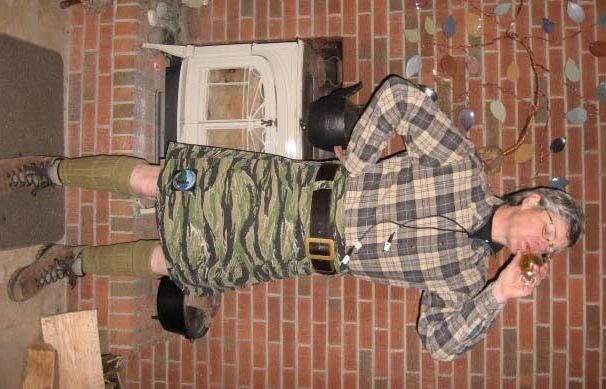|
-
21st January 09, 12:03 PM
#4
Effects of Kilt Yardage on Body Heat Loss: Conclusion
Conclusions
The traditional 8-yard wool kilt is indeed warmer in the rear and while standing still. As soon as motion is introduced, the advantage of the 8-yard kilt is rapidly diminished. Within three minutes, the air temperature in the rear of the 8-yard kilt became insignificantly different from that of both of the other test kilts. I conclude that the swish that is the hallmark of a heavy kilt serves to flush the air from beneath and from between the pleats, thus in large part negating the increased R value of the fabric when compared to lighter garments. Indeed, all kilts apparently lose most of the heat retained in the pleated section once walking motion is introduced. This study also demonstrated that while walking, the 4-yard kilt (and the lightweight poly/cotton kilt!) retained more heat in the front than did the 8-yard kilt, again, the bellows effect apparently trumps the insulative value of the material itself. These findings indicate that if you are walking in cold air, and with all other factors held constant, a 4-yard box-pleated kilt may keep you warmer than an 8-yard knife-pleated kilt.
In the initial phases of data collection it became obvious that wind, in this case even a very light breeze, significantly affected the retained heat within a kilt. The effect of wind may not be directly comparable to the effect of walking, since the motion induced by wind does not typically result in a rhythmic swinging of the pleats. It would be interesting to conduct further tests on the effects of wind, but that would require a controlled environment (a wind tunnel or some other well-controlled wind source), and after standing in –2 degree C temperatures for nearly two hours, the last thing I wanted to do was to stand in front of a fan. Clearly wind results in a loss of heat from beneath a kilt, and my best guess is that, at least in light to moderate winds, this loss would be significant regardless of kilt material and construction. Further study is warranted to answer this question.
Of particular note is the difference in standing front and standing rear temperatures within each kilt. In both the 8-yard and the poly/cotton kilts, the difference between these two temperatures was significant (see figures 6 and 8), but the difference between front and rear temperatures in the 4-yard kilt (figure 7) was statistically insignificant. Indeed, front and rear temperatures in this kilt were nearly identical. Matt Newsome, Curator of the Scottish Tartans Museum, kiltmaker, and advocate of the box-pleated kilt style, has written in several articles that the box-pleated kilt, having similar amounts of material in the front and rear, is a more “balanced” kilt than is the more common 8-yard kilt. The results of this study provide objective, numerical support for this assertion.
Can the results of this study provide insights into the relative merits of the three kilts in summertime temperatures? Kilt wearers know that the bellows effect does work effectively in flushing warm air from beneath a kilt in warm weather, assuming that the wearer is indeed walking. The effect of sunlight, especially on darker-colored materials, would play a significant role as well. These questions could be easily answered with a follow-up study conducted during warmer weather conditions, and I may indeed be conducting this research at a later date (assuming anyone really wants to know how hot it gets under a kilt while standing in the sun in front of a clan tent at a Highland Games event in July). Perhaps some questions are better left unanswered.
Acknowledgements: First and foremost, X-Marks members piperdbh and Howard Clark suggested this as a topic for serious research. My fondness for the Mythbusters television show, and all the wonderful gadgets they invent to test various urban myths, played a pivotal role in the design of this study. Finally, I acknowledge the support of my loving wife and two sons, who didn’t laugh (well, they did laugh a little) when given this grand opportunity to make sport of my latest craziness. My youngest son did take most of the photographs.
For a printed version of this article on high-gloss paper, refer to the Journal of Geriatric Kilting, vol. 37, pages 34-51. The video didn’t turn out too well, so the planned YouTube version of the testing procedure is, unfortunately, not available.

Warm at last! CHEERS!!!!
Last edited by Tartan Hiker; 21st January 09 at 08:30 PM.
Kilted Teacher and Wilderness Ranger and proud member of Clan Donald, USA
Happy patron of Jack of the Wood Celtic Pub and Highland Brewery in beautiful, walkable, and very kilt-friendly Asheville, NC.
New home of Sierra Nevada AND New Belgium breweries!
-
Similar Threads
-
By ChromeScholar in forum General Kilt Talk
Replies: 5
Last Post: 6th January 08, 03:42 PM
-
By souzaphone711 in forum General Kilt Talk
Replies: 30
Last Post: 23rd March 07, 11:47 AM
-
By freddie in forum Kilt Advice
Replies: 3
Last Post: 1st April 06, 10:14 PM
-
By toadinakilt in forum General Kilt Talk
Replies: 2
Last Post: 30th July 05, 05:07 PM
 Posting Permissions
Posting Permissions
- You may not post new threads
- You may not post replies
- You may not post attachments
- You may not edit your posts
-
Forum Rules
|
|
















Bookmarks